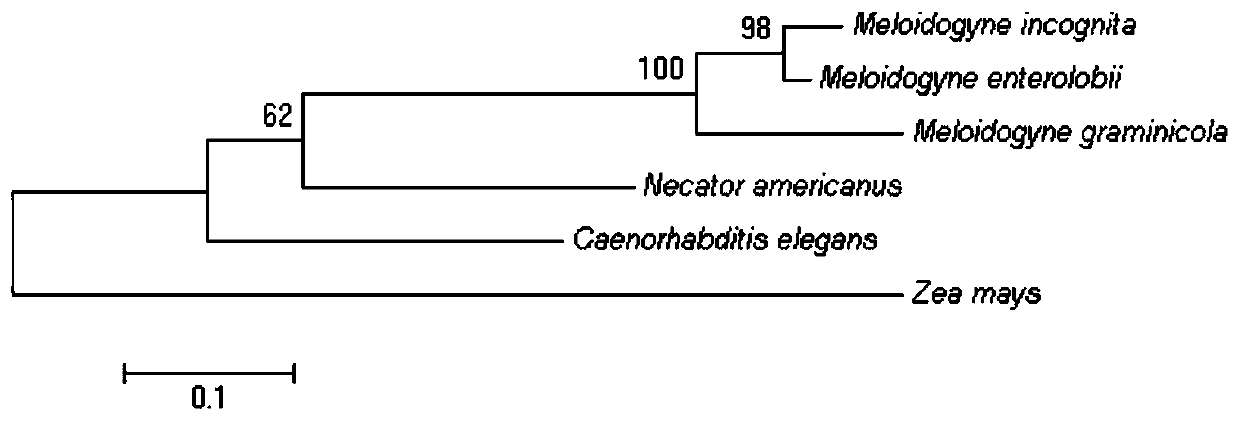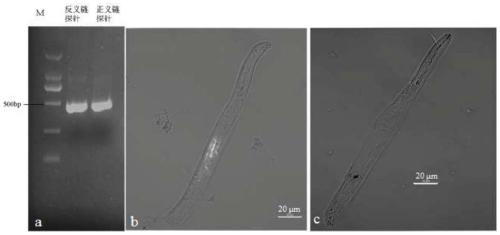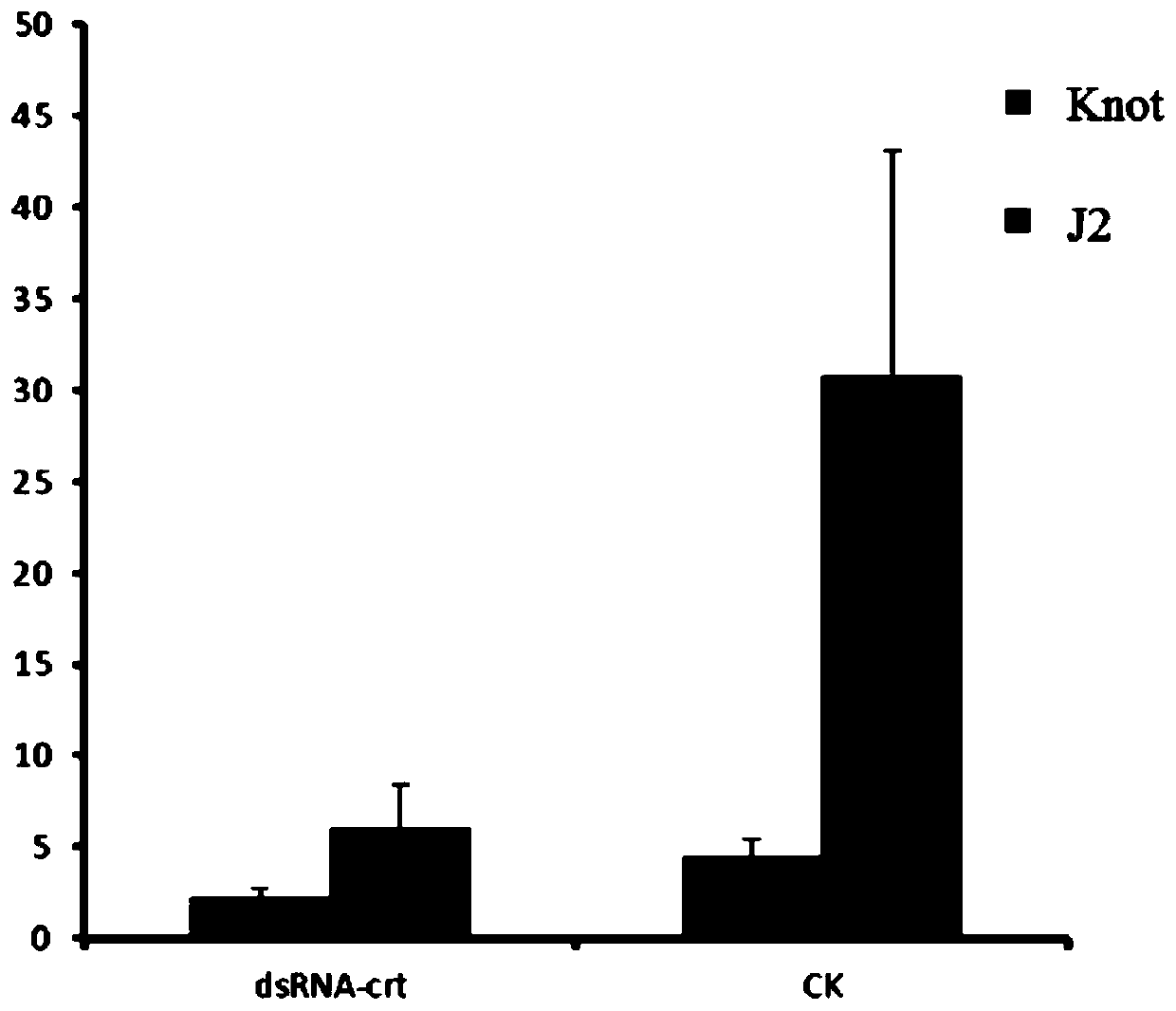Calprotectin gene of Meloidogyne graminicola and application of calprotectin gene
A root-knot nematode and calreticulin technology, which can be used in applications, nematicides, genetic engineering, etc., can solve problems such as large side effects, economic losses, and agricultural production hazards
- Summary
- Abstract
- Description
- Claims
- Application Information
AI Technical Summary
Problems solved by technology
Method used
Image
Examples
Embodiment 1
[0029] Embodiment 1: DNA extraction of root-knot nematode Pseudomonas graminearum
[0030] 1. Extraction of total RNA
[0031] Use TRIZOL Reagent to extract total RNA, the steps are as follows:
[0032] 1) ddH used in the RNA extraction process 2 O, centrifuge tubes and tips, etc. are treated with 0.1% DEPC.
[0033] 2) Collect root-knot nematode Pseudomonas graminearum in a 1.5mL centrifuge tube, freeze quickly in liquid nitrogen, add 200 μL Trizol, grind it thoroughly with a micro tissue homogenizer, then add 800 μL Trizol, mix well, and let stand at room temperature for 5 minutes;
[0034] 3) Add 200 μL of chloroform, shake fully, place at room temperature for 3 minutes, and centrifuge at 12,000 rpm at 4°C for 15 minutes;
[0035] 4) Pipette the supernatant into another 1.5mL centrifuge tube, add 550μL isopropanol, mix well, let stand at room temperature for 10min, and centrifuge at 12000rpm at 4°C for 10min;
[0036] 5) Discard the supernatant, add 1mL 75% ethanol to e...
Embodiment 2
[0046] Embodiment 2: the cloning of calreticulin gene (MgCRT) of root-knot nematode calreticulin (MgCRT)
[0047]The M. graminearum transcriptome data were spliced and compared one by one, and a 1712bp sequence was obtained, which was highly similar to the M. incognita CTR sequence, and the sequence already contained the complete 5' end and ORF of the CRT gene. Sequence, the 3' sequence is incomplete, according to this sequence, design and verify primers, see Table 1, use the cDNA obtained in Example 1 to perform PCR amplification.
[0048] Table 1 Primer Sequence
[0049] Primer sequence Mgcrt-F-57 5′-ACGAAGATTAAGAATGGCCG-3′ Mgcrt-R-656 5′-CTTTCTGCCTTTTCGCCATC-3′ Mgcrt-ORF-F 5′-TCTAAACATAAGAGCGACTACGG-3′ Mgcrt-ORF-R 5′-GTGCGGTATTTGGTAGGGAG-3′
[0050] PCR reaction system: 1 μL cDNA, 1 μL primer F (10 μM), 1 μL primer R (10 μM), 2.5 μL 10×Buffer, 2 μL dNTP (2.5 mM), 0.2 μL Taq, 16.3 μL dd H 2 O.
[0051] PCR reaction conditions:...
Embodiment 3
[0056] Embodiment 3: RACE technology clones the full-length sequence of MgCRT gene
[0057] According to the obtained calreticulin gene sequence of root-knot nematode graminearum, the specific primer Mgcrt-R3' (5'-ACATTTGCGGACCTGGAAC-3') and the 3' adapter primer were designed for nested PCR. reaction to amplify the 3' end sequence of the target gene. According to 3′-Full RACE Core Set with PrimeScript TM RTase (TAKARA) operating instructions, use 3'RACE Adapter primers for reverse transcription reaction, synthesize 1st Strand cDNA; use specific primers and 3'RACE Outer Primer for PCR reaction to obtain target fragments for sequencing, and compare the obtained sequences with known sequences The full-length sequence of calreticulin (MgCRT) cDNA was obtained by splicing. The full length of MgCRT gene cDNA is 1715bp, and its nucleotide sequence is shown in SEQ ID NO.1, which contains an open reading frame (ORF) of 1248bp. The cDNA open reading frame encodes 415 amino acids, an...
PUM
 Login to View More
Login to View More Abstract
Description
Claims
Application Information
 Login to View More
Login to View More - R&D
- Intellectual Property
- Life Sciences
- Materials
- Tech Scout
- Unparalleled Data Quality
- Higher Quality Content
- 60% Fewer Hallucinations
Browse by: Latest US Patents, China's latest patents, Technical Efficacy Thesaurus, Application Domain, Technology Topic, Popular Technical Reports.
© 2025 PatSnap. All rights reserved.Legal|Privacy policy|Modern Slavery Act Transparency Statement|Sitemap|About US| Contact US: help@patsnap.com



